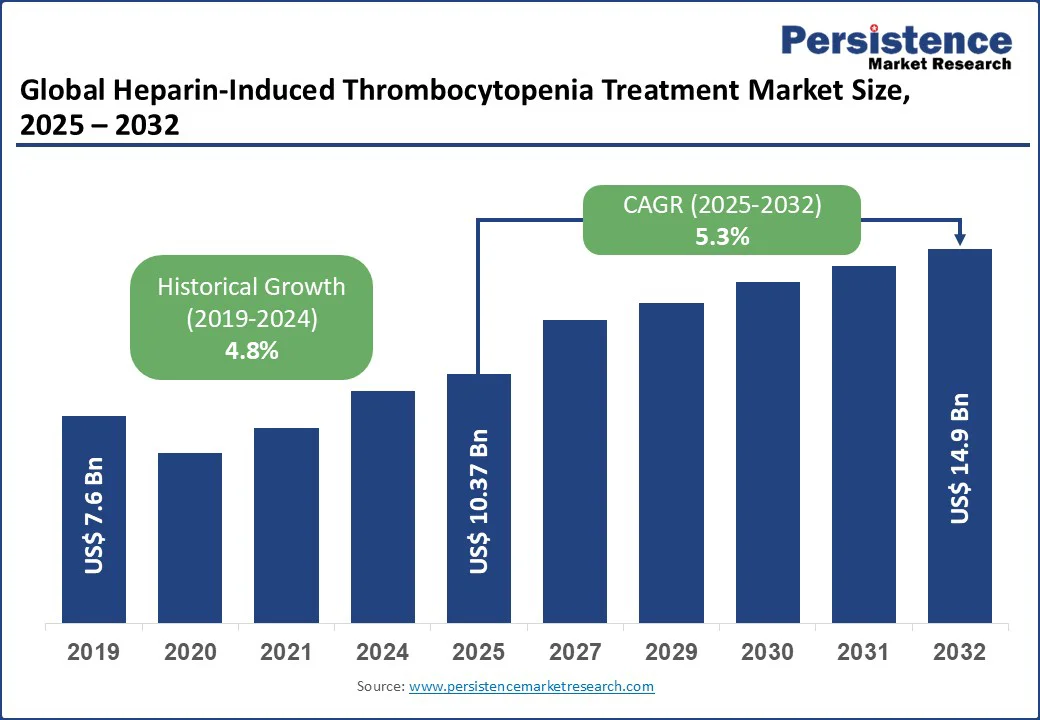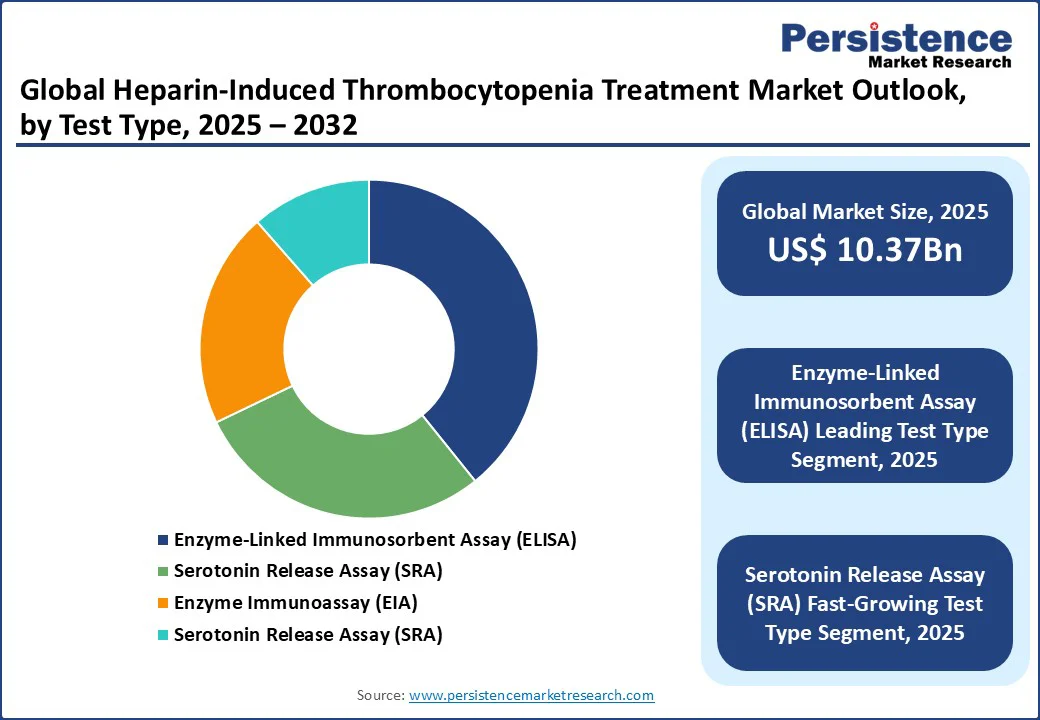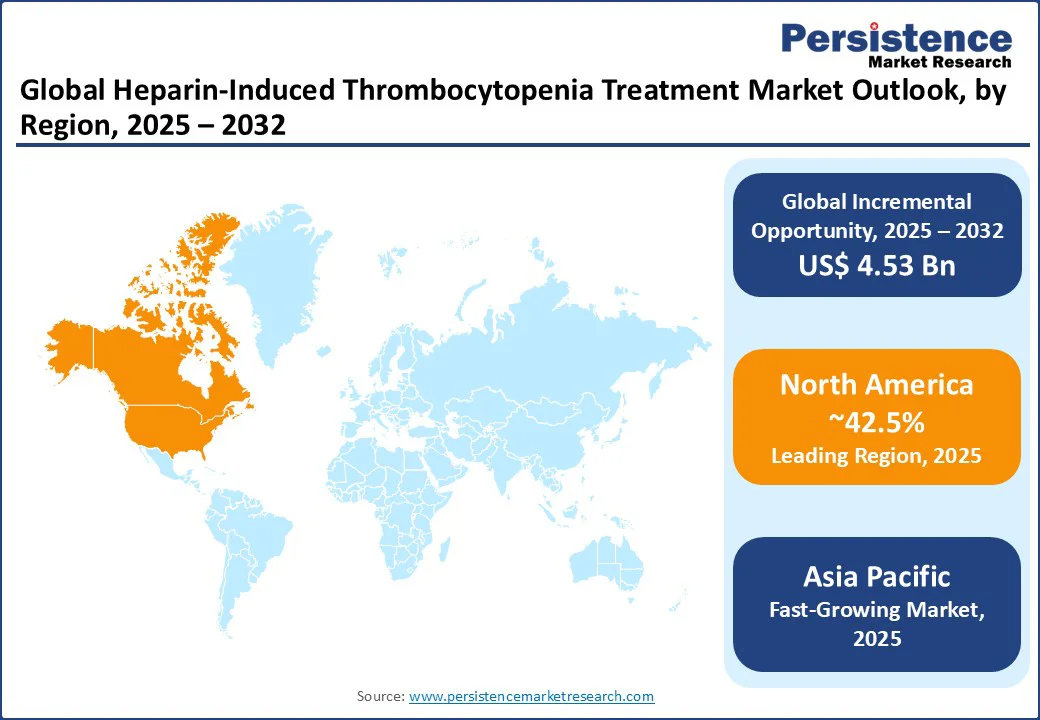ID: PMRREP27295| 198 Pages | 2 Sep 2025 | Format: PDF, Excel, PPT* | Healthcare

The global heparin-induced thrombocytopenia (HIT) treatment market size is likely to value at US$10.37 Bn in 2025 and reach US$14.9 Bn by 2032, growing at a CAGR of 5.3% during the forecast period from 2025 to 2032.
The heparin-induced thrombocytopenia treatment market is witnessing steady growth, driven by increasing demand from key healthcare sectors such as hospitals and specialized clinics, where rapid diagnosis and effective management of HIT are critical.
Heparin-Induced thrombocytopenia treatment, involving non-heparin anticoagulants such as Argatroban and advanced diagnostic assays is essential for managing this immune-mediated complication of heparin therapy. The rise in global surgical procedures, coupled with advancements in diagnostic technologies, supports market expansion.
Key Industry Highlights:

|
Global Market Attribute |
Key Insights |
|
Heparin-Induced Thrombocytopenia Treatment Market Size (2025E) |
US$ 10.37Bn |
|
Market Value Forecast (2032F) |
US$ 14.9Bn |
|
Projected Growth (CAGR 2025 to 2032) |
5.3% |
|
Historical Market Growth (CAGR 2019 to 2024) |
4.8% |
The global Heparin-Induced Thrombocytopenia (HIT) treatment market is gaining strong momentum, primarily driven by the increasing number of surgical procedures and the extensive use of heparin as an anticoagulant.
Heparin is a standard drug in surgeries such as cardiac bypass, dialysis, and venous thromboembolism (VTE) management, all of which contribute to a growing pool of patients at risk for HIT-a serious immune-mediated reaction to heparin. In the U.S. alone, more than 600,000 percutaneous coronary interventions (PCIs) and nearly 400,000 coronary artery bypass grafts (CABGs) are performed annually.
In Asia Pacific, countries such as China and India are fueling demand through major public health initiatives. China’s National Health Commission plans to expand intensive care services significantly by 2025 while India’s National Health Mission (NHM) continues to scale access to critical care, boosting heparin administration in surgical and ICU settings. Additionally, Pfizer reported a rise in Argatroban sales in 2024, underscoring increased HIT diagnosis and management.
The heparin-induced thrombocytopenia treatment market faces challenges due to the high costs of advanced diagnostic assays and competition from alternative anticoagulants. Diagnostic tools such as enzyme-linked Immunosorbent assays (ELISA) and serotonin release assays (SRA) require specialized equipment and skilled personnel, increasing operational costs. In 2023, diagnostic assay costs fluctuated, impacting affordability for smaller healthcare providers. This cost burden limits adoption, particularly in resource-constrained regions.
Additionally, direct oral anticoagulants (DOACs), such as rivaroxaban, are gaining traction due to their ease of use and reduced monitoring needs. Limited awareness in some regions and concerns over assay availability in harsh healthcare environments further hinder adoption, particularly in cost-sensitive markets, restraining overall market growth.
The increasing focus on precision medicine and novel anticoagulant development presents significant opportunities for the Heparin-Induced Thrombocytopenia Treatment market. Advanced therapies, such as bivalirudin and next-generation direct thrombin inhibitors, are critical for personalized HIT management in critical care settings.
In the hospital sector, HIT treatments are used in tailored protocols for high-risk patients. Companies such as Veralox Therapeutics are innovating with drugs such as VLX-1005 for HIT applications, aligning with personalized medicine trends.
Government incentives, such as the EU’s Horizon Europe program, further encourage investments in novel therapies, creating opportunities for manufacturers to develop advanced, patient-specific Heparin-Induced Thrombocytopenia Treatments to meet evolving healthcare needs through 2032.

North America dominates the Heparin-Induced Thrombocytopenia Treatment market, accounting for 42.5%, driven by robust demand from hospital and diagnostic sectors in the U.S. and Canada, supported by advanced healthcare infrastructure. The U.S. healthcare industry reached $4.9 trillion, accounting for 17.6% of GDP in 2023 relies heavily on HIT treatments for surgical and critical care applications.
Canada’s hospital sector drives demand for advanced diagnostics, per the Canadian Medical Association. Major players such as Pfizer and Eagle Pharmaceuticals dominate with extensive distribution networks, catering to healthcare projects such as ICU expansions and cardiac care upgrades. Consumer preference for high-quality, rapid diagnostics further strengthens North America’s market position.
Asia Pacific is poised to achieve a fastest-growth, fueled by rapid healthcare infrastructure growth, increasing surgical volumes, and high heparin usage in countries such as China and India. China, a major pharmaceutical hub, contributes significantly to global heparin production, per the World Health Organization, driving the availability of Heparin-Induced Thrombocytopenia Treatment.
India’s healthcare sector, supported by initiatives such as the National Health Mission, boosts demand for hospital-grade therapies. The region’s dialysis and cardiac surgery industries also contribute, with companies such as ACG Group and Syntegon Technology expanding their presence. Rising healthcare manufacturing and government-led projects ensure the Asia Pacific’s rapid market growth through 2032.
Europe is the second fastest-growing region for the Heparin-Induced Thrombocytopenia Treatment market, driven by stringent regulatory standards, rising demand in hospital and specialized clinic sectors, and healthcare development in countries such as Germany and France. In 2022, the European Union (EU) allocated approximately €1.3 trillion to current healthcare expenditure, equating to about 10.4% of its Gross Domestic Product (GDP), which supports demand for HIT treatments in surgical and diagnostic applications.
Germany’s hospital sector, a key consumer of advanced assays, benefits from players such as Korber AG and Marchesini Group. The EU’s Horizon Europe program promotes precision medicine projects, increasing demand for novel anticoagulants in critical care settings. Europe’s focus on regulatory compliance and high-quality standards drives market growth, with companies innovating to meet clinical and patient demands.

The global heparin-induced thrombocytopenia treatment market is highly competitive, dominated by extensive product portfolios and global distribution networks. The heparin-induced thrombocytopenia treatment market is characterized as a fragmented market based on competitors due to the presence of numerous domestic and international players, ranging from large, established companies to smaller, regional manufacturers.
Regional players such as ACG Group focus on localized offerings in the Asia Pacific. Companies are investing in advanced diagnostic technologies and novel anticoagulants to enhance market share, driven by demand for high-performance treatments in hospital and specialized clinic sectors.
The Heparin-induced Thrombocytopenia Treatment market is projected to reach US$10.37 Bn in 2025.
Rising surgical volumes and heparin usage, along with expanding applications in precision medicine, are the key market drivers.
The Heparin-induced Thrombocytopenia Treatment market is poised to witness a CAGR of 5.3% from 2025 to 2032.
The rising demand in precision medicine and novel anticoagulant development is the key market opportunity.
ACG Group, Inc., Korber AG, Romaco Group, Marchesini Group S.p.A., and Coesia S.p.A. are key market players.
|
Report Attribute |
Details |
|
Historical Data/Actuals |
2019 - 2024 |
|
Forecast Period |
2025 - 2032 |
|
Market Analysis Units |
Value: US$ Bn/Mn, Volume: As Applicable |
|
Geographical Coverage |
|
|
Segmental Coverage |
|
|
Competitive Analysis |
|
|
Report Highlights |
|
|
Customization and Pricing |
Available upon request |
By Drug Type
By Test Type
By End-use
By Region
Delivery Timelines
For more information on this report and its delivery timelines please get in touch with our sales team.
About Author